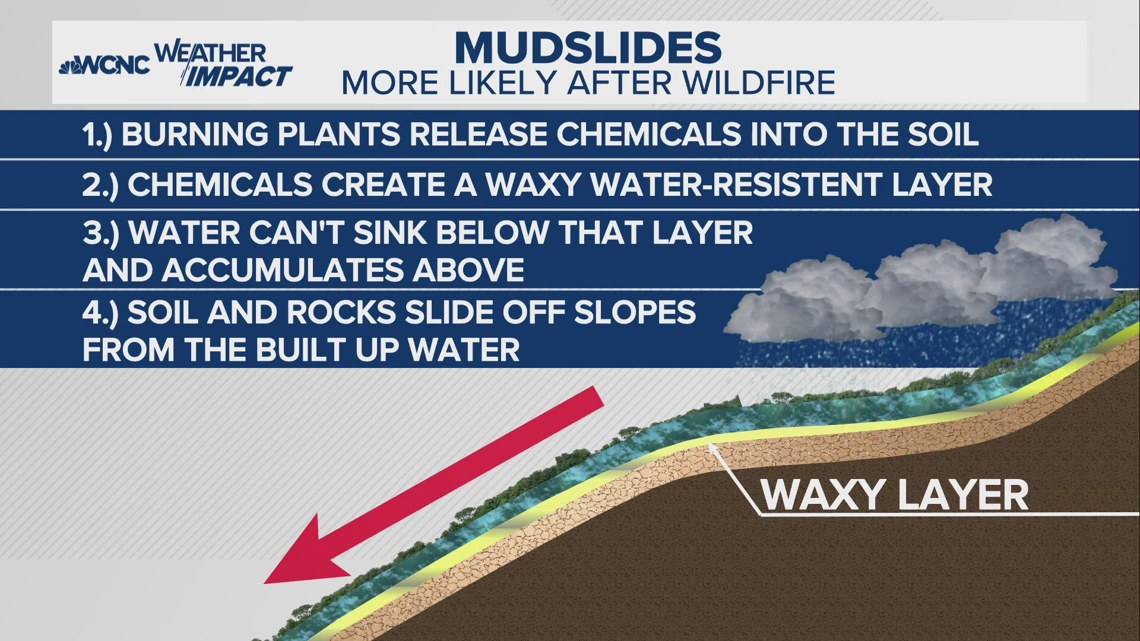Why the Southern California mudslides happened and what hazards follow?

Southern California had epic mudslides the day before Valentine’s Day that carried debris and cars out of neighborhoods. Here is how and why it happened and the risk
LOS ANGELES COUNTY, Calif. — Southern California cannot get a break. After wildfires in January, an atmospheric river brought even more rain to a region that has been primed for mudslides.
The same Los Angeles County residents recovering from wildfires are now dealing with massive mudslides and flash floods. And while Southern California saw mudslides a few weeks after the fires, they weren’t of this magnitude.
As we showed you live on WCNC+, a Runyon Canyon neighborhood in L.A. was a scene like no other. Mud and fast-moving, water rushing down the streets, flowing into local businesses, shutting down roads and even easily carrying cars away. Officials say mudslides closed some of the Pacific Coast Highway and a debris flow dumped 8 inches of mud in the Hollywood Hills.
That mud became increasingly more powerful as it flowed right into the Pacific Ocean, carrying a vehicle along with it. The driver escaped, according to the Los Angeles Fire Department.
Why did this happen?
Landslides happen when rocks, debris and the physical earth (ground) moves down a steep slope, most commonly a mountain or canyon wall. A mudslide is a landslide that is fast-moving and flows in a channel. Mudslides are also known as a debris flow.
Heavy rain, earthquakes, volcanic eruptions, wildfires and droughts can all be factors that cause landslides. The mudslides in Southern California were caused by a surge of rain driven by an atmospheric river.
Mudslides develop when water accumulates quickly and causes the physical land to fall down a steep slope. Human development and ground modification can make hills and mountain slopes more prone to mudslides, mainly because vegetation that holds the ground together has been destroyed. They are also common around:
- Channels along streams/rivers
- Slopes at the bottom of canyons
- Places prone to surface runoff during heavy rain events
- Areas where landslides have occurred before
The most common time for mudslides is when heavy rain falls after a drought and even more so after a wildfire. But why?
Mudslides after wildfires


To summarize the graphic above. A fire will change the chemical composition of the topsoil, This makes a waxy layer that allows water and dirt to slide dangerously fast, leading to devastating mudslides like what Southern California experienced on Feb. 13.
Health impacts and risks
According to the United States Centers for Disease, Control and Prevention (CDC), the United States has 25 to 50 landslides and debris flow-related deaths each year. The health hazards associated with landslides and mudflows include:
- Rapidly moving water and debris that can lead to trauma. (People in North Carolina after Hurricane Helene are currently still recovering and dealing with this. Trauma can take years to overcome, and some people aren’t able to overcome it).
- Broken electrical, water, gas and sewage lines that can result in injury or illness.
- Disrupted roadways and railways can endanger motorists and disrupt transport and access to health care.
After a mudslide
Find the nearest high ground in the direction away from the path. Always stay away from where it happened because there can be secondary mudslides and landflow.
Stay updated with local weather reports and a radio station that will update residents with the most pertinent information. Look for trees, telephone poles and walls that may be askew, as they are at risk of falling. If you see a bare spot on a hillside or mountainside, stay away.
Avoid streams and rivers downstream from these events. Water can rise in seconds and a roaring wall of muddy water and debris could wipe away anything (including you) from its path. The only warning for these will be a rumbling sound. If it is growing louder, run to higher ground.
Contact Chris Mulcahy at cmulcahy@wcnc.com and follow him on Facebook, X, Instagram and TikTok.


